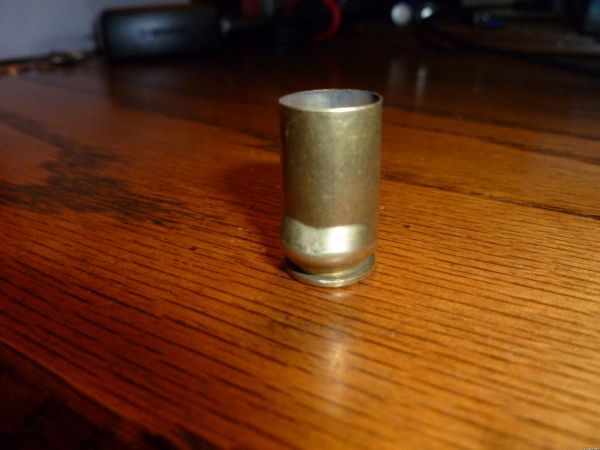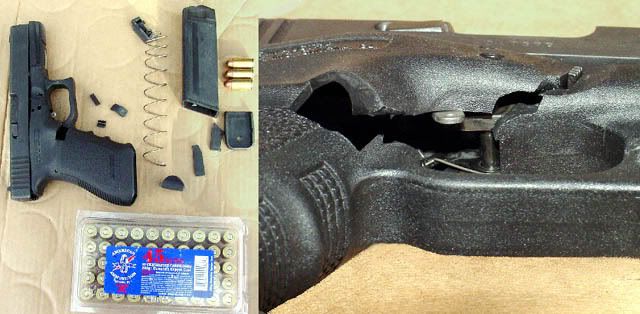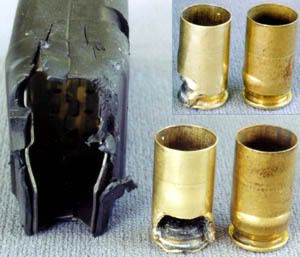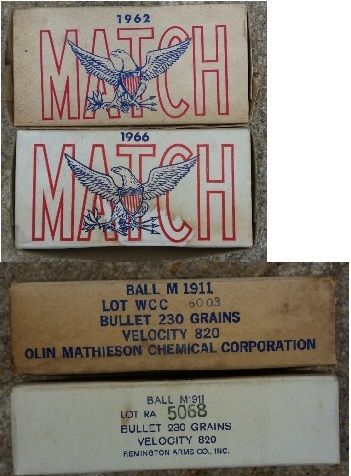You are using an out of date browser. It may not display this or other websites correctly.
You should upgrade or use an alternative browser.
You should upgrade or use an alternative browser.
.45 colt Bullseye load
- Thread starter Jeryray
- Start date
3.8 to start
You answered your own question.
I'm a little confused. Do you mean 45 Colt or 45 Automatic (Colt Pistol), also known as 45 ACP? 45 Colt and 45 Automatic (ACP) are two totally different cartridges. 5.0gr of Bullseye is the listed max for a 230gr bullet in 45 Automatic. In 45 Colt max is 7.1gr of Bullseye with a 230gr bullet. Big difference. Which 45 are you loading for?
I assume you are asking about the 45 ACP and are developing a load for a M1911. Basically, for a M1911, the minimum load is the lightest load that will function your pistol, while sending the bullet downrange. Bullseye Pistol shooters desire to shoot the absolute minimum loads for the rapid fire sequences, and to do this, very few are running stock 16 lb springs. I am running a 13 lb spring in my Bullseye Pistol, with powder puff 200 LSWC loads.
One of the issues of running absolute minimum loads is short stroking, where the pistol ejects the case, but does not pick up the round from the magazine. Another failure mechanism which I have encountered time and again, are stove pipe jams, where the case does not clear the ejection port before the slide goes forward. I have also found that low power loads developed in 70 F weather where stove piping in cold weather. I was running a 200 LSWC with 3.5 grains Bullseye for the rapids, and it worked perfectly in Spring and Summer. But in winter conditions, I had stovepipe jams. I decided to bump up the load for cold weather use.
Loads that are too hot are more difficult to diagnose in the M1911, because the round is so low pressure. Too hot of loads you will have vicious and hard ejection. I quit using Blue Dot and Unique after seeing 20 foot case ejections. Those powders gave too much pressure at unlock and were overaccelerating the slide, which leads to frame peening.
These loads were positively dangerous as the sidewall is horribly stretched.

This is what happens when the sidewall is blown. The ammunition in this picture was AMERC which was some of the worst commercial ammunition ever, it blew up rifles and pistols, and this is an example of a Glock which was damaged of overpressure ammunition.



The military load pushed a 230 FMJ just at 800 fps in a M1911. For decades, the standard Ball load, for Bullseye shooters, was a 230 FMJ with 5.0 grains Bullseye. This is a very accurate and reliable load, been used world wide under all environmental conditions. That should be your maximum load.

One of the issues of running absolute minimum loads is short stroking, where the pistol ejects the case, but does not pick up the round from the magazine. Another failure mechanism which I have encountered time and again, are stove pipe jams, where the case does not clear the ejection port before the slide goes forward. I have also found that low power loads developed in 70 F weather where stove piping in cold weather. I was running a 200 LSWC with 3.5 grains Bullseye for the rapids, and it worked perfectly in Spring and Summer. But in winter conditions, I had stovepipe jams. I decided to bump up the load for cold weather use.
Loads that are too hot are more difficult to diagnose in the M1911, because the round is so low pressure. Too hot of loads you will have vicious and hard ejection. I quit using Blue Dot and Unique after seeing 20 foot case ejections. Those powders gave too much pressure at unlock and were overaccelerating the slide, which leads to frame peening.
These loads were positively dangerous as the sidewall is horribly stretched.

This is what happens when the sidewall is blown. The ammunition in this picture was AMERC which was some of the worst commercial ammunition ever, it blew up rifles and pistols, and this is an example of a Glock which was damaged of overpressure ammunition.



The military load pushed a 230 FMJ just at 800 fps in a M1911. For decades, the standard Ball load, for Bullseye shooters, was a 230 FMJ with 5.0 grains Bullseye. This is a very accurate and reliable load, been used world wide under all environmental conditions. That should be your maximum load.

Code:
[SIZE="3"]230 LFN Bull-X 3.5 grs Bullseye Mixed Brass WLP
OAL 1.20" taper crimp .469"
8-Jan-06 T = 61 °F
Ave Vel = 643.6
Std Dev = 14.07
ES = 63.63
High = 679.9
Low = 616.3
N = 32
shot a little high Pistol cycled each shot
230 LFN Bull-X 4.0 grs Bullseye Mixed Brass WLP
OAL 1.20" taper crimp .469"
8-Jan-06 T = 61 °F
Ave Vel = 715.9
Std Dev = 11.45
ES = 48.32
High = 742.9
Low = 694.8
N = 32
shot a little low
230 gr LRN 4.0 grs Bullseye Mixed Brass WLP
OAL 1.250" taper crimp .469"
29-Jan-06 T = 68 °F
Ave Vel = 698.8
Std Dev = 10.19
ES = 36.33
High = 713.5
Low = 677.1
N = 28
Little High = put close point of aim V. Accurate
230 gr LRN 4.5 grs Bullseye Mixed Brass WLP
21-Jun-06 T = 97 °F
OAL 1.250" taper crimp .469"
Ave Vel = 805.2
Std Dev =11.4
ES=54.08
High=836.9
Low=782.8
N =32
230 gr FMJ (R-P) 5.0 grs Bullseye 99' & 2005 mixed lot Mixed Brass WLP (brass) OAL 1.265" taper crimp .469"
12-Dec-11 T= 53 °F
Ave Vel = 793.5
Std Dev = 18.92
ES = 61.99
High = 817.4
Low = 755.4
N = 16
[URL=http://smg.photobucket.com/user/SlamFire/media/Pistols%20various/KimberRightSideDSCN0753.jpg.html][IMG]http://img.photobucket.com/albums/v479/SlamFire/Pistols%20various/KimberRightSideDSCN0753.jpg[/IMG][/URL][/SIZE]I'd assume the OP is loading 45 colt (aka long colt) because who calls 45 acp 45 colt?
But I like the fail safe of assuming he's using a 45 acp (but he did specify colt, check the head stamp on a 45 colt. It says 45 colt, 45 acp says 45 acp or 45 auto) as a fail safe.
I have some bullseye I have to load for 45 long colt (aka 45 colt) but don't have the gun. Yet. But I run jacketed bullets atm
Sent from my SM-G900V using Tapatalk
But I like the fail safe of assuming he's using a 45 acp (but he did specify colt, check the head stamp on a 45 colt. It says 45 colt, 45 acp says 45 acp or 45 auto) as a fail safe.
I have some bullseye I have to load for 45 long colt (aka 45 colt) but don't have the gun. Yet. But I run jacketed bullets atm
Sent from my SM-G900V using Tapatalk
My Bullseye (competition) load is a 200 Cast SWC with Federal primer, 4.2 of Bullseye powder. Some go as light as 3.5 of Bullseye for the 25 yard stages and use the 4.2 for 50 yards. I don't know what a good 230 hardball load is, don't shoot it.
I do sort the cases for bullseye. You did mean 45 ACP not 45 Colt, Right?
I do sort the cases for bullseye. You did mean 45 ACP not 45 Colt, Right?
5.0gr of Bullseye is the listed max for a 230gr bullet in 45 Automatic
Alliant lists the max for 230 gr FMJ @ 5.7 gr of Bullseye.
